Athena Review Vol. 5, no. 1
Records of Life: Fossils as Original Sources
16. Synapsids 1: Pelycosaurs to Therapsids
The term synapsid (“one arch” or "one opening") was originally used by Romer (1956) as a grouping of the class of reptiles, referring to those whose skulls had one aperture on each side, as contrasted to both anapsids (“no arches”) and diapsids (two arches). The term synapsid is now used to distinguish the reptilian ancestors of mammals from the ancestors of later reptiles, who split from each other quite early.
Pelycosaurs
Pelycosaurs (“pelvis lizards”), who emerged during the Late Pennsylvanian period (330-310 mya), were synapsids with early versions of differentiated teeth which featured larger canines, and a developing hard palate. By the end of the Pennsylvanian, early pelycosaurs called Ophiaconodonts (“snake-teeth”) gave rise to another group of Pelycosaurs, the Sphenacodonts (“wedge-point teeth”), who lived through most of the Permian. The Sphenacodonts, in turn, gave rise to the Therapsids (“beast-faces”), a name coined for mammal-like reptiles, in contrast to "lizard faced" Sauropsid reptiles.
The Therapsids, a category now seen as too heterogenous for precise usage in cladistics, were nevertheless an important group with six major families which already had various mammal-like traits, including lactation. One of these, the Cynodonts (“dog-teeth”), were the direct ancestors of mammals. As discussed in a later section, during the late Triassic and early Jurassic periods (230-150 mya), early mammals evolved from very similar Cynodonts.
Ophiacodontidae
Ophiacodonts (“snake-teeth”), dating from the Late Pennsylvanian and early Permian periods (about 300-280 mya) were a family of a large (2-5 m long), carnivorous pelycosaurs. They represent the earliest-known family of synapsids considered direct ancestors of mammals. The family Ophiacondontidae gave rise to at least five major lines of synapsids in the Permian, all considered as Pelycosaurs. These included Eothyridids, Varonopsids, Caseids, Edaphosaurids such as the large sail-back herbivore Edaphasaurus boanergi, and Sphenacodonts, all well represented in the fossil record. Only the latter group, however, the Sphenacodonts, are considered ancestral to mammals; the other four families are “sister taxa” of Sphenacodonts.
Archaeothyris florensis (fig.x) was an ophiacodontid synapsid that lived during the Late Carboniferous and is known from Nova Scotia, where it was described by Reisz (1982). Dated to 306 million years ago, Archaeothyris, along with a more poorly known synapsid called Echinerpeton, are among the oldest known synapsids.
 The
name Archaeothyris means "ancient window" (Greek), and refers to the opening in the
skull, the temporal fenestra, which indicates this is an early
synapsid.
The
name Archaeothyris means "ancient window" (Greek), and refers to the opening in the
skull, the temporal fenestra, which indicates this is an early
synapsid. Fig.x: Reconstruction of A. florensis (after Reisz 1982)
Archaeothyris was somewhat more advanced than the early sauropsids, having strong jaws that could open wider than those of the early reptiles. Its robust lower jaw was attached to the skull by a diagonal muscle fastened through the fenestra or hole behind the eye. This arrangement provided more force or leverage in chewing or biting.While its sharp teeth were all of the same shape, Archeothyrus also had enlarged upper canines, which indicates it was a carnivore. Based on fragmentary postcranial material Archaeothyris' legs were articulated laterally at its pelvis and shoulders, which gave it a sprawling stance.
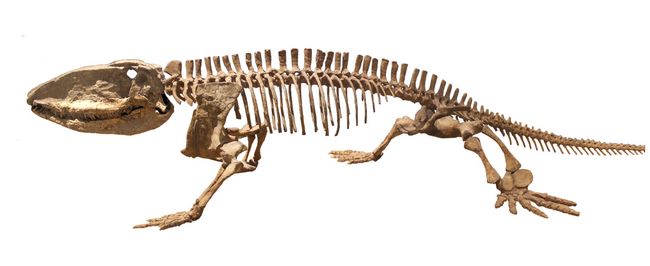 Ophiacodon retroversus (fig.x), who lived in the Early Permian at about
290 mya, was first defined by Cope in 1878. Ophiacodon was derived from
a sister taxon of the much smaller Archaeothyris. Ophiacodon had a mixture
of traits, with many aspects of the skull, postcranial skeleton and
dentition retaining amphibian features. It reached 4 m in length and
had a long narrow skull, which may have been best suited for fish
eating.
Ophiacodon retroversus (fig.x), who lived in the Early Permian at about
290 mya, was first defined by Cope in 1878. Ophiacodon was derived from
a sister taxon of the much smaller Archaeothyris. Ophiacodon had a mixture
of traits, with many aspects of the skull, postcranial skeleton and
dentition retaining amphibian features. It reached 4 m in length and
had a long narrow skull, which may have been best suited for fish
eating. Fig.x: Ophacodon retroversus skeleton (Field Museum of Natural History)
Compared to Archaeothyrus, Ophiacodon showed several advanced skeletal features related to mammals, including shorter cervical and lumbar vertebrae. It also had elongated neural spines on the vertebra, although nowhere near as long as those of the later sailbacked Dimetrodon and other Sphenacodonts. The skull of O. retroversus, like that of the earlier Archaeothyris, had the typical Synapsid single aperture behind the eye orbit, used as a muscle attachment in conjunction with stronger chewing muscles and enlarged canine teeth in the upper jaw or maxilla. Both the canine teeth and the skull aperture were smaller than those of Archaeothyris. Also distinct from Archaeothyris, the skull of Ophiacodon was relatively larger and had a larger rostrum or frontal area, with an upwardly curving mandible, which itself developed an opening or fenestra.
Caseids
One of the earliest synapsid now known is Eocasia martinis, a juvenile fossil found in Late Pennsylvanian Calhoun Shale Formation in Hamilton Quarry in Greenwood County, Kansas. dating from 300 mya. This locality, a fossil lagerstatte (sedimentary deposit with extraordinary fossil preservation) represented a tidally influenced valley in the Late Pennsylvanian period, where a diverse flora and fauna has bee
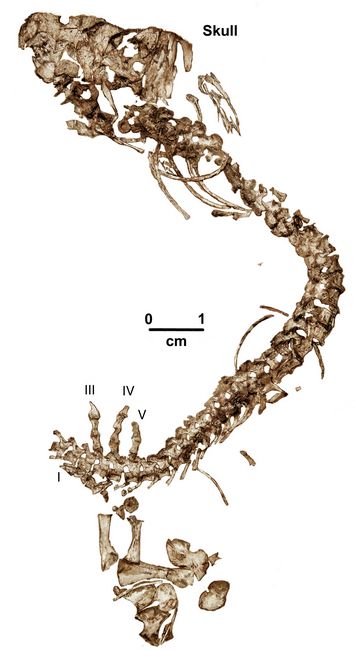 n preserved, including fish and amphibians.
n preserved, including fish and amphibians.The Eocasea martinis fossil (named for Dr. Larry Martin) includes the pelvic girdle and the right hind limb preserved along with most of the vertebra and the skull, the latter in crushed condition. The E. martinis juvenile has been interpreted by Reisz and Fröbisch (2014) to belong to the Caseid group, which included both carnivores and herbivores, and ultimately evolved into mammals.
Eocasea lived not very long after the earliest reptiles, who were amniotes, were derived from non-amniotic amphibian reptilioforms, which occurred during the Mississippian or Early Carboniferous period at about 315 mya.
Fig.x: Eocasea martinis (after Reisz and Fröbisch 2014)
Eocasea represents an herbivore, about 15 cm long, with a narrow rib cage, simple cone-shaped teeth, and a much smaller body size than later caseids which had wide bodies and specialized, serrated teeth for chewing plants. The finding of Eocasea closes a gap of about 20 million years to the next youngest members of the caseid family, indicating that caseid synapsids were earlier than previously known from the fossil record. Caseids were one of the first groups of tetrapods to evolve into herbivores.
Edaphasaurids
Edaphasaurus boanergi was a large herbivore reptile
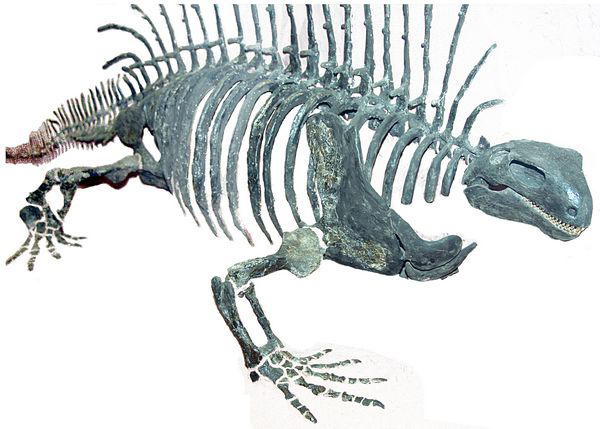 from the Early Permian period (280 mya) who had a sail-like structure
on its back made of elongated neural spines. It was discovered in
the Permian Basin of north Texas.
from the Early Permian period (280 mya) who had a sail-like structure
on its back made of elongated neural spines. It was discovered in
the Permian Basin of north Texas.As a synapsid reptile, Edaphasurus is in the group ancestral to mammals. It shares numerous features with the contemporary synapsid Dimetrodon, a carnivore who also had a sail-like projection on its back.
.
Fig.x: Edaphasaurus boanergi (Yale Peabody Museum; photo: Athena Review)
Sphenacodonts
Sphenocodonts were large carnivorous pelycosaurs with distinctive “sail backs,” composed of skin-covered, elongated neural spines on their vertebra. Genera which descended from the earlier Ophiocodonts included Ctenospondylus, Dimetrodon (fig.x), Secodontosaurus, and Sphenacodon. These were the dominant carnivores of the Early Permian (299-270 mya).
Dimetrodon (“two teeth sizes”), a genus named by Cope in 1878 for outsized canines compared to its other teeth, is a sister genus to Sphenocodon and is not considered a direct ancestor of mammals. Since it is well known, however, from abundant fossils in the Permian Basin in Texas and Oklahoma, as well as in finds from Germany, it provides a useful model for sphenacodont anatomy.

Of the twelve recognized species of Dimetrodon the largest, D. grandis, was 3.2 m long (10 ft), and the smallest, D. Teutonis, 60 cm (2 ft) long. Its most distinctive feature is the “sailback” composed of very long neural spines on its vertebra, an area which some have suggested was used for body temperature regulation. If so, this represented an early form of homeostasis. Other research, however, suggests a display role for the tall sails in Dimetrodon and Edaphosaurus (Huttenlocker et al. 2011) Compared to earlier pelycosaurs, Dimetrodon also had longer transverse spines as attachments for locomotion or walking muscles.
Fig.x: Dimetrodon skeleton
The skull of Dimetrodon (fig.x) had medium-sized skull apertures or fenestra. Compared with Archaeothyris or Ophiocodon, its teeth were further differentiated along mammalian lines, with small incisors, two huge deep- rooted upper canines on each side, and smaller cheek teeth, all replaced continuously in the reptilian manner. Its jaw hinge, comprised of the quadrate and articular bones, was fully reptilian (contrasted with the eventual mammalian jaw hinge of the dentary and squamosal bones).
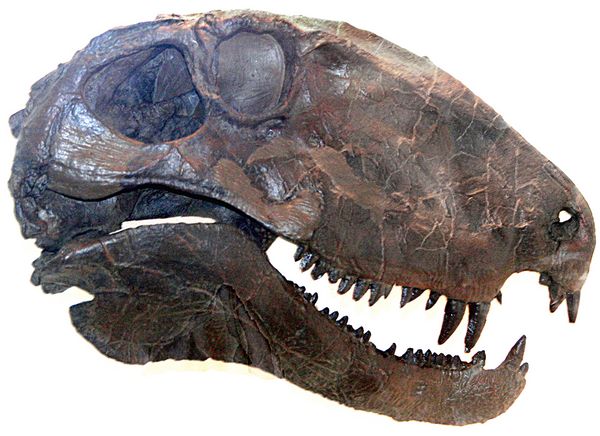
Dimetrodon also had a primitive reptilian middle ear, hearing only ground-borne vibrations. Its lower jaw, however, included the first signs of a bony prong later to become part of the reptilian eardrum as the columella or stapes, which sensed air-borne sound vibrations. Reptiles retained the stapes as a single ossicle in the middle ear, while early mammals developed three ossicles, the same as today: stapes,incus, and malleus, the latter two being reformed and miniaturized reptile jaw bones. (As the middle ear development is considered highly diagnostic for identifying early mammal fossils, the subject will be discussed in more detail in a later section.)
Fig.x: Skull of Dimetrodon (Amer.Mus.Nat.Hist; photo: Athena Review)
Sphenacodon, the type genus for the Sphenacodontidae family, was a synapsid carnivore between 2 and 3 m in length. American paleontologist O.C. Marsh (1878) first named Sphenacodon ferox (“fierce wedge-pointed teeth”) for its back teeth with sharp cutting edges. All examples of S. ferox have been found in the Early Permian redbeds of northern New Mexico or the Utah-Arizona border region, representing ancient deltaic and riverine environments. In 1937, Alfred S. Romer described a second species from New Mexico named Sphenacodon ferocior ("fiercer") that was larger and more robust, with proportionately longer neural spines. Romer and Price (1940) provided detailed descriptions of both S. ferox and S. ferocior with skeletal reconstructions.
Sphenacodon and its sister genus Dimetrodon were contemporary predators from the Early Permian, hunting amphibians and early synapsid and diapsid reptiles. Their fossils have typically have been found in different but
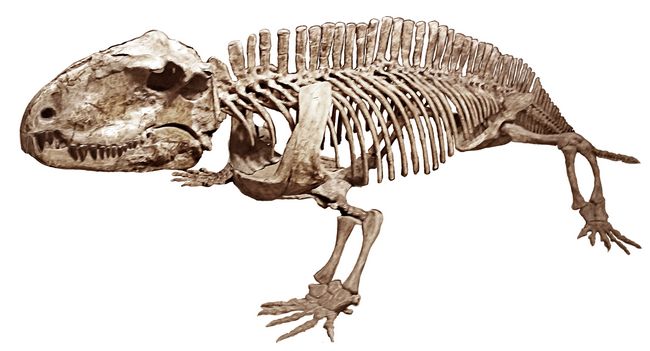 adjacent geographical areas,
separated during that period by an inland sea called the ancient Hueco
Seaway that covered parts of New Mexico and west Texas (Lucas 2011). Dimetrodon is mainly known from Texas and Oklahoma , although the species D.occidentalis
is found in New Mexico (Berman 1977; Lucas et al 2009). Sphenacodon died out before about 280 mya during the
Wolfcampian phase of the Permian, while Dimetrodon survived until about
270 million years ago..
adjacent geographical areas,
separated during that period by an inland sea called the ancient Hueco
Seaway that covered parts of New Mexico and west Texas (Lucas 2011). Dimetrodon is mainly known from Texas and Oklahoma , although the species D.occidentalis
is found in New Mexico (Berman 1977; Lucas et al 2009). Sphenacodon died out before about 280 mya during the
Wolfcampian phase of the Permian, while Dimetrodon survived until about
270 million years ago..Fig.x: Sphenacodon ferox (Field Museum of Natural History)
The skull of Sphenacodon is very similar to that of Dimetrodon, with the same array of skull bones (Romer and Prince 1940) It is narrow from side to side and vertically deep, with an indented notch at the front of the maxillary bone in the upper jaw. The upper and lower jaws are equipped with an array of powerful teeth, divided into large “canines" (called caniniforms), with sharp pointed "incisors" (precaniniforms) in front, and smaller slicing back teeth (postcaniniforms). The eye orbit is set high and far back, with a single aperture or temporal fenestra behind and partly below the eye.
Body proportions are also similar to Dimetrodon, with a very large head, short neck, robust trunk, relatively short front and hind limbs, and a tapering tail that makes up about half the animal's entire length. However, the tops of the neural spines along the back bone are strikingly shorter than in the sailback Dimetrodon. In Sphenacodon (fix.x), the neural spines are enlarged but retain a flat-tipped, blade-like shape along the back and tail, and form a crest rather than a tall sail. In both Sphenacodon and Dimetrodon, there is evidence for strong muscles along the base of the raised neural spine, which likely helping to stiffen and strengthen the backbone for walking and for lunging at prey by restricting side-to-side flexing motion.
.
Therapsids
Sphenacodonts were ancestral to the order of Therapsids (“beast-faces”), a term considered synonymous with “mammal-like reptiles.” The Therapsids comprised six synapsid families or sister taxa which had evolved during the middle and Late Permian, after the decline of the Sphenacodonts and the large “sailback” carnivore taxa of the Early Permian. Three of these, the Dinocephalia, Eotitanosuchids and Gorgonopsids (“gorgon-faces”), did not survive the massive end-of Permian extinction; a fourth, the Therocephalids, lasted into the Early Triassic. Only two of the Therapsid groups, the Dicynodonts and the Cynodonts, survived through the Triassic.
One of these, the Cynodonts (“dog-teeth”), provided the next, and final, ancestral link between synapsids and mammals during the Late Triassic and early Jurassic. The Dicynodonts, meanwhile, seem to have become extinct by the end of the Triassic.
Biarmosuchians
Biarmosuchians, one of the earliest, most basal suborders of therapsids, were carnivores who lived during the Middle and Late Permian period (275-252 mya). Biarmosuchians were significantly smaller than Sphenacodonts, and were typically lightly built. The type species, Biarmosuchus tener (fig.x), about the size of a jackal or dog, was found in the Russian Urals. Biarmosuchians are known from both Russia (as Phthinosuchus, Biarmosuchus, and Eotitanosuchus) and South Africa (as Ictidorhinidae, Burnetiidae, and related forms).
The biarmosuchian skull is very similar to the sphenacodont skull. Among the retained, primitive, sphenacodontid features were jaw muscles inside the skull, and a slightly backward-sloping, platelike occiput at the base of the skull,
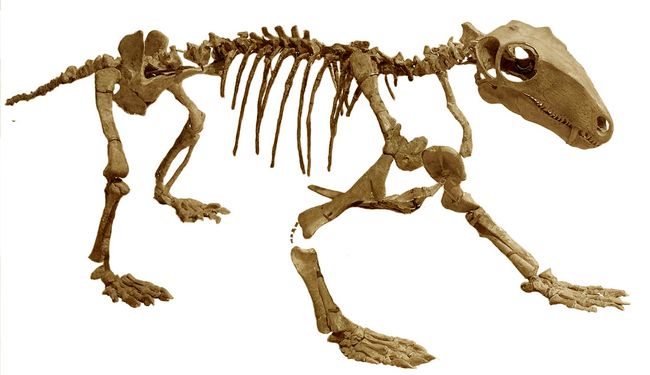 the reverse of the pelycosaur condition where
the occipital plate slanted forwards. Here it is attached still more
strongly to the braincase. There is a reduced number of
teeth, and single large canine teeth in both upper and lower jaws. The jaw hinge is more mammalian in position and shape, with
mammalian-like jaw-closing muscle stronger, resulting in a stronger
bite, as indicated by the flaring of the rear of the skull where these
muscles were attached. The old amphibian-like hinged upper jaw has now
been replaced by a fixed or immovable maxilla.
the reverse of the pelycosaur condition where
the occipital plate slanted forwards. Here it is attached still more
strongly to the braincase. There is a reduced number of
teeth, and single large canine teeth in both upper and lower jaws. The jaw hinge is more mammalian in position and shape, with
mammalian-like jaw-closing muscle stronger, resulting in a stronger
bite, as indicated by the flaring of the rear of the skull where these
muscles were attached. The old amphibian-like hinged upper jaw has now
been replaced by a fixed or immovable maxilla. Fig.x: Biarmosuchus tener (Dinosaurium exhibition, Prague, Czech Republic; photo: Radim Holis).
The vertebrae of Biarmosuchus remained like those of sphenacodontid, although they lacked the long neural spines that distinguish Dimetrodon and its kin. Alterations in the shoulder and pelvic girdles and the limbs, meanwhile, are highly significant. All indicate a much more advanced posture and a radical alteration in the method of locomotion, with a much more mobile forelimb, more upright hindlimb, and more mammalian femur and pelvis.The feet are more symmetrical, indicating that they faced forward throughout the stride, and the phalanges (toes) are reduced in length so that they are more like that of later synapsids, including both therapsids and mammals (Carroll 1988).The toes were approaching equal length, as in mammals, with the number of toe bones varying from reptilian to mammalian. The neck and tail vertebrae became distinctly different from trunk vertebrae.
Finally, Biarmorsuchus probably had a primitive eardrum in the lower jaw, located by the jaw hinge (the quadrate bone, which contained the stapes or columella). Such gradual changes in the reptilian jaw hinge leading to the mammalian middle ear elements are important traits in the evolution from Therapsids to early mammals.
Gorgonopsidae
Gorgonopsidae are medium to large-size therapsid carnivores from the Late Permian with many advanced, mammal-like features. A number of genera have been found in the Karoo Basin of South Africa, where the group was first identified by Owen in 1876. Eva Gebauer (2007) reevaluated the relationships between various Gorgonopsid taxa, based on finds in the Ruhuhu Valley of Tanzania in the 1930s by Nowack (Von Huene 1950). A main concentration is on Sauroctonus parringtoni, which shows close similarities the Russian genus Sauroctonus, establishing for the first time a link between Tanzania and Russia in the Late Permian Pangaea. Sauroctonus appears to have been a highly efficient predator, with surprisingly close analogies to the Pleistocene saber-toothed cat, Smilodon (who postdated Sauroctonus by 250 million years.)
References:
Berman 1977;
Carroll 1988
Cope in 1878
Lucas 2011
Lucas et al 2009
O.C. Marsh (1878)
Reisz (1982).
Reisz, R.R. and J.Fröbisch 2014. The Oldest Caseid Synapsid from the Late Pennsylvanian of Kansas, and the Evolution of Herbivory in Terrestrial Vertebrates. PLoS ONE. 9 (4).
Romer and Prince 1940.
Glossary